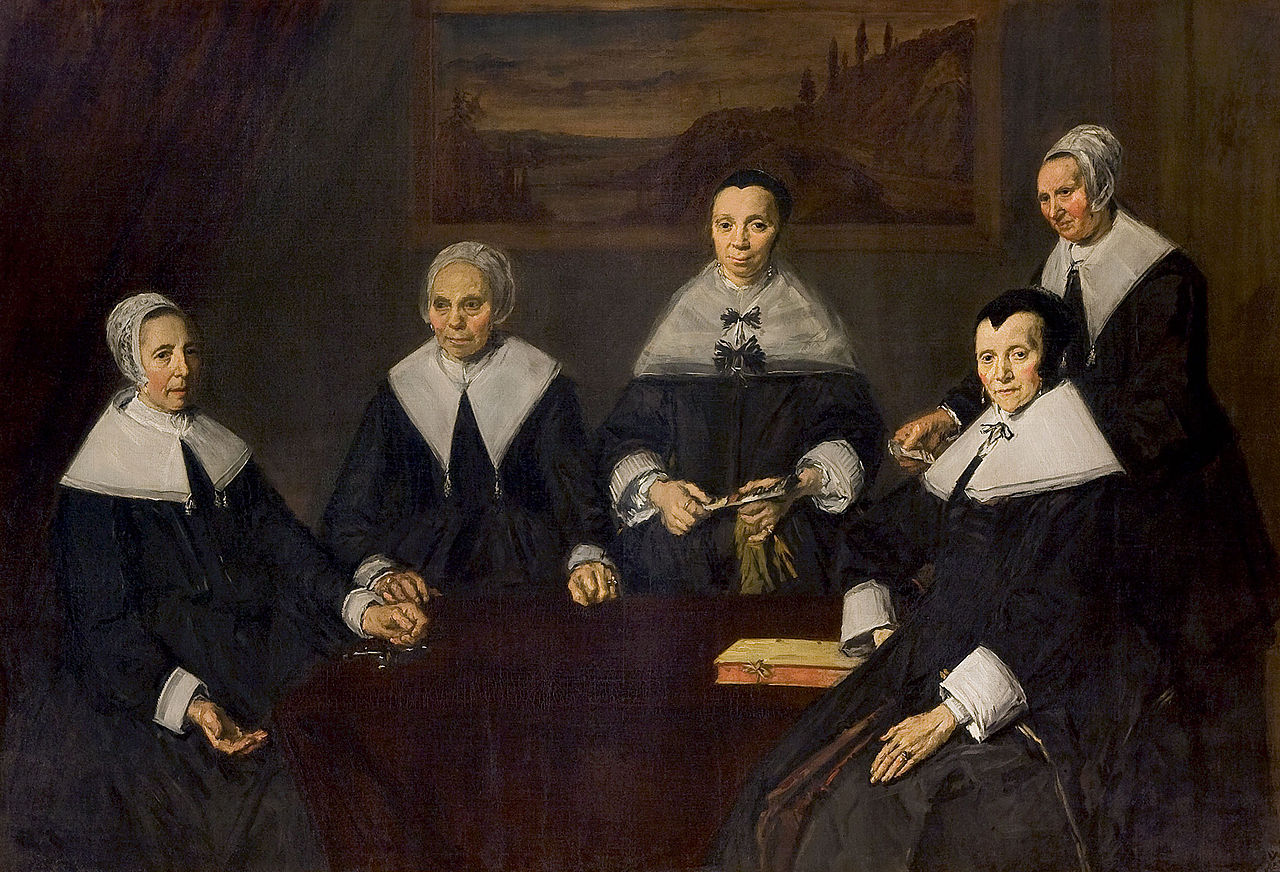
A section is dedicated to Martha Jungwirth’s most recent series inspired by the paintings of old masters, such as Frans Hals, Francisco de Goya, or Édouard Manet. The analysis of the Viennese artist’s brushstroke and palette reveals affinities with these painters, which can be seen in both the gestural stroke and the colors chosen.
AFTER FRANS HALS
The extraordinary ability to capture fleeting facial expressions with free brushstrokes made Frans Hals (b. ca. 1582; d. 1666) one of the greatest portraitists of the Dutch Golden Age.
Hals’s portraits feel immediate and spontaneous. He started by outlining the motif directly on the canvas and then building up the different layers while working with rapid brushstrokes that appear to blend in the distance. With drier brushstrokes he created the final details, evoking textile effects like embroidery or lace cuffs.
Known for his warm palette, Hals’s use of color became more restricted over the years, as can be seen in his 1664 painting Regentesses of the Old Men’s Alms House. In this group portrait, Hals rendered five women predominantly in black, except for their white collars and cuffs and their blushing cheeks.
Some of art history’s greatest painters have studied and copied this masterpiece. In gallery 205, you can see Jungwirth’s 2014 work Untitled, from the series Female Regents of the Old Men’s Almshouse, Frans Hals, 1664. Jungwirth preserves unpainted portions of the background amid her dense, energetic brushstrokes and blotches, through which the dark attire, collars, and hands of the sitters seem to emerge.
AFTER FRANCISCO DE GOYA
Francisco de Goya (b. 1746; d. 1828) is considered one of the pioneers of modern art. He is recognized for his unique approach to addressing social, economic, and political issues that were prevalent in Spain during his time. His innovative use of color and gesture was a significant breakthrough in the art world and further elevated his status and influence.
Goya’s signature colors included lead white, Naples yellow, yellow ochre, dark ochre, bright red, Venice red, vermilion, burnt sienna, carmine red, cobalt blue, earth umber, burnt umber, and ivory black. But oftentimes he used a more restrained palette, like in Witches’ Flight, a painting that anticipates the expressiveness of his famous Black Paintings.
Goya painted with sable and badger brushes, but to stain the canvas he would use a sponge or even his fingers. For areas of thicker impastos, he would use a palette knife or drag a laden thin brush with paint to create more tactile surfaces on details of the painting.
Jungwirth has painted several works after some of Goya’s best-known paintings. In Untitled from the series Witches’ Flight (2022), in gallery 209, the pointed hats of the witches as well as the color palette are reminiscent of the master’s painting. However, Jungwirth isolates the figures in four separate sheets of paper, saturating the green of the hat and fleshy pinks and applying colors with a laden brush.
rosados de los rostros.
AFTER ÉDOUARD MANET
Edouard Manet (b. 1832; d. 1883) is a pivotal figure in the development of modern art, and his works prefigured Impressionism, specially for his radical way of handling colors and for working alla prima— that is, “wet on wet.” An expert in the technique, Manet employed brushstrokes that were expressive and appreciable, yet technically accurate. He included bodily movement in his paintings, precisely applying dabs with his brush. However, what seems a spontaneous gesture in his paintings is in fact the result of a very meticulous procedure. At night, Manet would often remove with a palette knife the impasto of what he painted during the day, returning to the underpaint layer, to start over again the following morning.
Manet attained brilliant effects in his motifs by suppressing the medium tones and applying higher contrast between light and shadows. He blended pigments with paint or applied the paint directly from the tube. He was very fond of black, a color lacking in the Impressionists’ palette, and he often used white, Naples yellow, and certain types of greens, like Goya. At the end of his life, clashing colors dominated Manet’s still lifes.
For her series Édouard Manet, The Asparagus (2023), on view in gallery 209, Jungwirth emphasized some of the yellows and mauves from the original painting. With seemingly effortless brushstrokes she evokes Manet’s asparagus bundle on a monumental scale.
Female Regents of the Old Men’s Almshouse, 1664
Frans Hals (1580-1666)
Oil on canvas
170.5 x 249.5 cm
Photo: René Gerritsen
Frans Hals Museum
